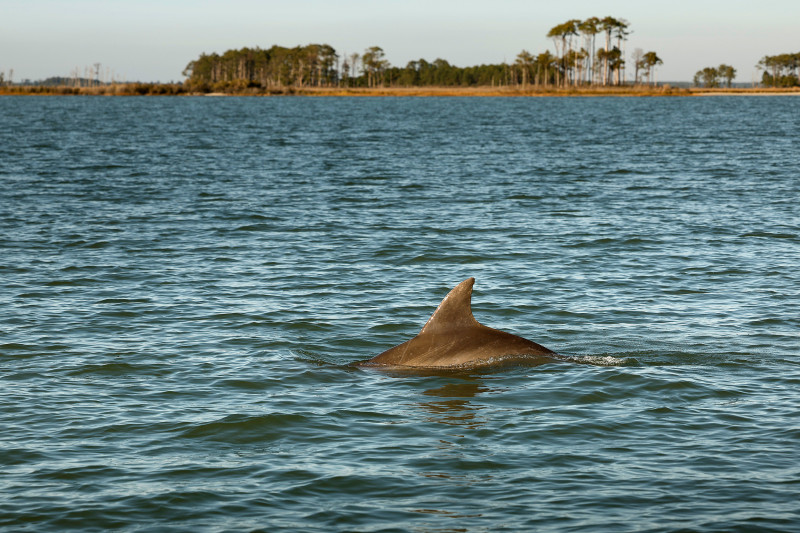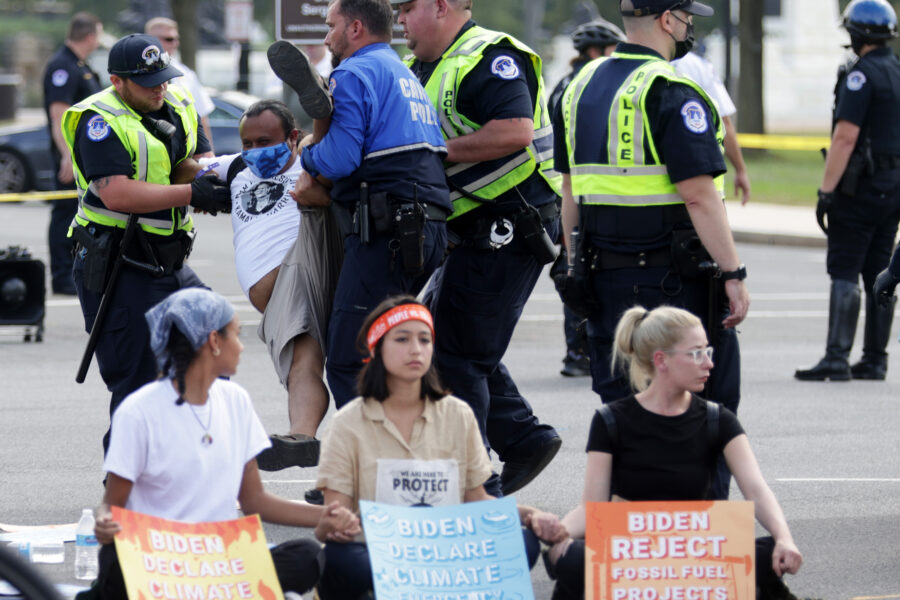The Chesapeake Bay Program Flunked Its 2025 Cleanup Goals. What Happens Next?
Agriculture and stormwater runoff from developed land—key reasons the Chesapeake Bay is not on target to meet 2025 cleanup goals—will continue to limit pollution reduction efforts until federal and state agencies come up with new approaches to tackle these longstanding problems.
That’s according to a recently published paper in the Environmental Law Reporter, which also warns that climate change makes cleanup efforts harder as increased rainfall and floods overwhelm stormwater systems and supercharge runoff pollution.
The EPA and the Bay jurisdictions agreed to the 2025 goals under the 2014 Chesapeake Bay Watershed agreement, which adopted a “total maximum daily load” of nitrogen, phosphorus and sediment, or TMDL— a nutrient diet to reduce this runoff and restore water quality across the Bay’s tidal rivers.
The TMDL’s annual nutrient pollution limits are divided among the partner jurisdictions—New York, Pennsylvania, Delaware, West Virginia, Maryland, Virginia and the District of Columbia. Each is responsible for implementing pollution control measures, including agricultural best practices and stormwater permits, to hit their TMDL targets. But runoff pollution in the region has worsened instead of improving.
We’re hiring!
Please take a look at the new openings in our newsroom.
See jobsThe Environmental Law Reporter analysis comes at a time when the dead zones in the Chesapeake Bay are expected to be slightly larger than average and began earlier than normal this year. That’s according to a forecast released by the Chesapeake Bay Program, which coordinates activities between the participating states and D.C.
Dead zones are areas in the Bay and its rivers that don’t contain enough oxygen to support underwater life such as fish, crabs and oysters. The annual dead zone forecast is linked to weather patterns and monitoring of nitrogen and phosphorus pollution entering the Bay.
The Chesapeake Bay Program has established a “Beyond 2025” committee to develop recommendations for future cleanup efforts. The committee’s recommendations are expected to be made public in early July and the final report will be delivered near the end of the year.
EPA is also working with the Beyond 2025 committee to develop a plan for what the next phase of restoration will be, an agency spokesperson told Inside Climate News.
It will be up to the states and the EPA to decide during the annual meeting of the Chesapeake Executive Council late this year whether to refocus the Bay cleanup efforts. The executive council consists of the governors of the six watershed states, the mayor of the District of Columbia, the chair of the Chesapeake Bay Commission and the EPA administrator. Maryland Gov. Wes Moore currently chairs the council.
“[D]espite four failed efforts over 40 years, some are calling for a new post-2025 Bay Agreement,” Jon Mueller, a legal scholar and former vice president for litigation at the nonprofit Chesapeake Bay Foundation, wrote in the new paper. If the new agreement “does not require mandatory actions and is not legally enforceable, a similar outcome is certain,” he wrote.
Anna Killius, executive director of the Chesapeake Bay Commission, which coordinates state-level action in Maryland, Virginia and Pennsylvania, and co-chair of the Bay Program’s Beyond 2025 Committee, said it was natural for the partners to consider the program’s progress every few years and assess “the goals that we’ve set for ourselves and the systems that we’ve created to meet those goals.”
Arguing that the program is not a failed endeavor but is going through “course correction,” Killius said, “we acknowledge that this is 40 years of partnership, and we’re trying to find that line between answering the urgency of the moment but not being so disruptive as to harm a partnership that’s 40 years in the making.”
The Bay partnership has gone through four iterations since its 1983 beginnings. The 2014 agreement that’s currently in force “was amended by the signatories in 2020 to address diversity, fish passage, and land use methods,” Mueller noted in his paper.
Covering over 64,000 square miles and fed by more than 150 rivers and streams, the Chesapeake Bay is the largest estuary in the U.S. A crown jewel among the nation’s natural resources and home to a diverse range of species and habitat, the Bay watershed is considered integral to the ecology and economy of the states it touches.

But poor water quality has proved to be an enduring problem. Since 2014, most of the partners’ efforts have focused on restoring dissolved oxygen in the Bay’s deepwater areas and reducing algal blooms that harm aquatic life and people.
“Major components of the ecosystem are compromised because water quality in the Bay and its tributaries remains degraded,” the paper stated.
A substantial number of the Bay cleanup targets remain off-course, especially those related to vital habitats, healthy watersheds and climate adaptation.
Key Issues Hampering the Bay Cleanup Efforts
In his paper, Mueller emphasizes three key factors that are necessary to restore the Bay: the EPA enforcing its congressionally mandated authority under the Clean Water Act; states using better approaches to rein in agricultural and residential stormwater runoff pollution; and the parties moving the Bay agreement from voluntary to a binding commitment.
In emailed comments, an EPA spokesperson said the agency takes a leadership role in the Bay partnership to improve water quality. “EPA has a dual role with respect to the Bay—as a partner as well as a regulator—and achieving restoration of the Bay requires more than leveraging fines,” the agency said. Since 2021, the statement noted, the EPA has worked with Pennsylvania, which passed legislation allocating $154 million to assist farmers with implementing practices to limit nutrient and sediment loading into Bay waters.
Agricultural runoff from Pennsylvania’s farmlands is the biggest contributor of nutrient pollution to the Bay. The state has been “dramatically off course,” according to Mueller, in achieving its TMDL targets.
“The Agency has also used its regulatory authority where appropriate to motivate states to achieve their goals,” the EPA statement said. “We have stepped up enforcement in all sectors—industrial, agricultural, urban and wastewater—and have continued to increase permitting oversight and compliance assistance in the agriculture and stormwater sectors.”
But a July 2023 report from the EPA’s Office of Inspector General, which the paper also mentioned, urged the agency to develop a new approach for addressing these pollution sources.
EPA had not adopted a strategy that accounts for new challenges to its pollution control efforts, such as climate change, the inspector general’s office said. Adding that the Bay Program was not on track to meet its 2025 TMDL targets for excess nutrients, the report noted that the federal agency had not urged the Bay jurisdictions to adopt new goals or update deadlines to address agricultural and other so-called “nonpoint” sources of runoff.
Adam Ortiz, the EPA’s Mid-Atlantic regional administrator, responded in a letter that the EPA does not have authority to impose a new strategy on the parties to the 2014 Chesapeake Bay Agreement.
“The top priority of Regional Administrator Ortiz has been to get out in the field and build strong relationships with the Pennsylvania agriculture community, farm bureau, local conservation districts, and the state legislature to advocate for more conservation programming and implementation of conservation practices,” an EPA spokesperson said in emailed comments.
Ortiz’s response to the inspector general report emphasized the agency’s limited options because the bay agreement is voluntary. But Mueller contested this assertion, citing instances where the EPA took enforcement action under the Clean Water Act to compel states to comply with their commitments to control pollution.
In 2015, the EPA revoked Pennsylvania’s grants when the state failed to provide an implementation plan that met the agency’s expectations, Mueller noted. The agency did not restore those funds until Pennsylvania developed and began to implement a plan to reduce agricultural pollution, his paper said.
But the agency has since refused to take similar actions, Mueller wrote, despite recognizing that Pennsylvania is significantly behind in pollution reduction from agricultural sources and that voluntary programs have not worked.
He pointed to a 2014 study by the Chesapeake Bay Foundation, which valued the Bay region’s economic benefits at about $107 billion annually. That would increase if jurisdictions fully implement their voluntary targets.
But the targets aren’t being met. Under that scenario, the foundation estimated, the Bay’s economic value would drop by $5.7 billion.
With the exception of West Virginia, all the states contributing runoff to the Bay are failing to meet their TMDL obligations, Mueller’s paper noted. He singled out Pennsylvania as “dramatically off course.” Maryland and Virginia are “off track” in reducing nitrogen and phosphorus from urban and suburban stormwater, he added.
Mueller noted that deficient stormwater permits and municipal storm sewer system permits are failing to control nutrient pollution, and weather extremes linked to climate change make the situation worse through excess rain and flooding.
The EPA has the authority to reject a deficient permit, Mueller wrote, but the agency didn’t take any action to force improvements.
“Some nonprofits in Maryland have twice or thrice challenged the general permit that the state has issued for urban stormwater to different counties but it never gets any better,” Mueller told Inside Climate News in an interview, referring to lawsuits filed in recent years.
If pollution discharge permits aren’t strengthened, he added, enforcement will not improve.
Maryland, in his estimation, is not paying much attention to urban stormwater runoff pollution. Under the previous administration of Larry Hogan, a Republican, the state’s environmental regulator saw its budget plummet, hollowing out the agency as experienced staff left.
The staff shortages weakened permit enforcement—hundreds of outdated general pollution discharge permits were allowed to function under “administrative continuance.” The agency also drew criticism for relaxed enforcement of environmental laws, in line with Hogan’s business-friendly policies, that failed to hold polluters accountable.
“Ultimately, EPA needs to be clear in its intentions or the Bay partnership is sure to collapse.”
In 2022, the agency informed the governor’s office and the General Assembly that it needed almost a hundred new employees to achieve its targets under Maryland’s Climate Solution Now Act of 2022, which required the agency to reduce a backlog of expired emissions permits, increase inspections and penalize violators. Today, the agency is still working to staff up. Gov. Wes Moore, a Democrat, has promised support for the agency in the current state budget.
The state’s development priorities also worry Mueller. “There’s significant development going on in Maryland, and the state takes the position that as long as the property is being developed according to environmental site design standards, it’s just as good as trees in good condition, and that’s just laughable,” he said.
Mueller said that political considerations should not dictate whether water quality and Bay-dependent communities suffer. “Ultimately, EPA needs to be clear in its intentions or the Bay partnership is sure to collapse,” he said. “Some partners have already expressed hesitation at signing another Bay agreement.”
Evan Isaacson, senior attorney and research director for the Chesapeake Legal Alliance, a regional nonprofit providing legal services to protect the estuary, said most of the reductions in nitrogen pollution over the decades have come from wastewater facilities as a result of Clean Water Act requirements. Clean Air Act mandates driving down coal plant pollution have also helped.
Simply providing funds to incentivize action is not a solution to the Bay’s problems, he said.
“I think this points to what has been most missing from today’s efforts to reach the 2025 Bay cleanup deadline: the basic implementation and enforcement of the Clean Water Act and our state and federal environmental laws,” Isaacson said.
2025 and Beyond
As the Beyond 2025 committee draws up possible future trajectories for the Bay program going forward, some environmental advocates and experts suggest shifting the focus of the cleanup efforts away from improving the quality of the bay’s deepwater areas. Instead, they want to prioritize the Bay’s habitats and tributaries that provide recreation and livelihoods for communities.
The argument for that change: Four decades of emphasis on restoring deepwater areas has not produced the desired results and has also diverted attention from other important areas, such as the Bay tributaries that support aquatic life.
“By focusing on shallow water areas, you can create drastic water quality improvements in a relatively short time period,” said Allison Colden, Maryland executive director of the Chesapeake Bay Foundation. “And if you’re able to do that in a big way across the entire watershed, then you’re going to start to see those cumulative benefits roll up into improvements that will start to move the needle for the open water and deep channel habitat.”
Chesapeake Legal Alliance’s Isaacson said the talk about shifting away from the main stem and deeper channel is happening mainly because jurisdictions failed to abide by their commitments to restore the Bay.
“This ‘shift’ is being proposed through the deliberations of the Beyond 2025 Steering Committee, and that body was only convened because EPA and the partnership admitted in late 2022 that the 2025 target was out of reach,” he said.
Switching to this approach would allow jurisdictions to try to restore the bodies of water they think are easier or cheaper to address than the deeper areas of the Bay, which rely almost exclusively on pollution reduction policies alone, Isaacson said.
”We should be moving full steam ahead with the Bay’s restoration through pollution reduction efforts designed to attain water quality standards everywhere,” Isaacson said.
The targets for a future Beyond 2025 Plan “are anyone’s guess,” Mueller said. “My fear has been that when the going got tough, folks would move the goalposts, and that seems like what is going on now.”
He added that water in the Bay comes from myriad sources and does not just all go directly to the deep channel. “If you work to address deep channel anoxia and hypoxia, you will see reductions in shallow areas,” Mueller said. “It’s fine if you want to give credit for implementation practices that help shallow waters, but do not give up on deep channel goals. They drive everything.”
Share this article
Disclaimer: The copyright of this article belongs to the original author. Reposting this article is solely for the purpose of information dissemination and does not constitute any investment advice. If there is any infringement, please contact us immediately. We will make corrections or deletions as necessary. Thank you.







